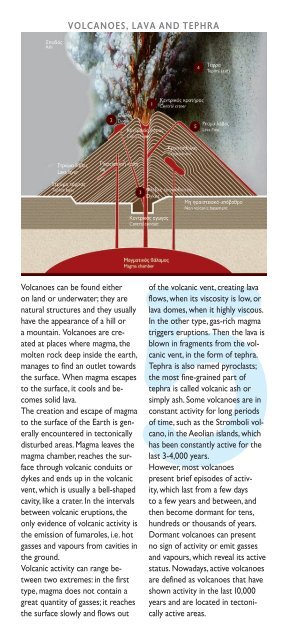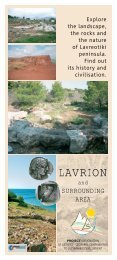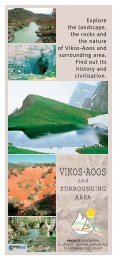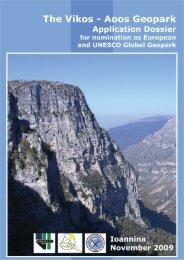NISYROS - Welcome to the Greek Geological Institute Web page ...
NISYROS - Welcome to the Greek Geological Institute Web page ...
NISYROS - Welcome to the Greek Geological Institute Web page ...
Create successful ePaper yourself
Turn your PDF publications into a flip-book with our unique Google optimized e-Paper software.
VOLCANOES, LAVA AND TEPHRA<br />
Volcanoes can be found ei<strong>the</strong>r<br />
on land or underwater; <strong>the</strong>y are<br />
natural structures and <strong>the</strong>y usually<br />
have <strong>the</strong> appearance of a hill or<br />
a mountain. Volcanoes are created<br />
at places where magma, <strong>the</strong><br />
molten rock deep inside <strong>the</strong> earth,<br />
manages <strong>to</strong> find an outlet <strong>to</strong>wards<br />
<strong>the</strong> surface. When magma escapes<br />
<strong>to</strong> <strong>the</strong> surface, it cools and becomes<br />
solid lava.<br />
The creation and escape of magma<br />
<strong>to</strong> <strong>the</strong> surface of <strong>the</strong> Earth is generally<br />
encountered in tec<strong>to</strong>nically<br />
disturbed areas. Magma leaves <strong>the</strong><br />
magma chamber, reaches <strong>the</strong> surface<br />
through volcanic conduits or<br />
dykes and ends up in <strong>the</strong> volcanic<br />
vent, which is usually a bell-shaped<br />
cavity, like a crater. In <strong>the</strong> intervals<br />
between volcanic eruptions, <strong>the</strong><br />
only evidence of volcanic activity is<br />
<strong>the</strong> emission of fumaroles, i.e. hot<br />
gasses and vapours from cavities in<br />
<strong>the</strong> ground.<br />
Volcanic activity can range between<br />
two extremes: in <strong>the</strong> first<br />
type, magma does not contain a<br />
great quantity of gasses; it reaches<br />
<strong>the</strong> surface slowly and flows out<br />
5<br />
of <strong>the</strong> volcanic vent, creating lava<br />
flows, when its viscosity is low, or<br />
lava domes, when it highly viscous.<br />
In <strong>the</strong> o<strong>the</strong>r type, gas-rich magma<br />
triggers eruptions. Then <strong>the</strong> lava is<br />
blown in fragments from <strong>the</strong> volcanic<br />
vent, in <strong>the</strong> form of tephra.<br />
Tephra is also named pyroclasts;<br />
<strong>the</strong> most fine-grained part of<br />
tephra is called volcanic ash or<br />
simply ash. Some volcanoes are in<br />
constant activity for long periods<br />
of time, such as <strong>the</strong> Stromboli volcano,<br />
in <strong>the</strong> Aeolian islands, which<br />
has been constantly active for <strong>the</strong><br />
last 3-4,000 years.<br />
However, most volcanoes<br />
present brief episodes of activity,<br />
which last from a few days<br />
<strong>to</strong> a few years and between, and<br />
<strong>the</strong>n become dormant for tens,<br />
hundreds or thousands of years.<br />
Dormant volcanoes can present<br />
no sign of activity or emit gasses<br />
and vapours, which reveal its active<br />
status. Nowadays, active volcanoes<br />
are defined as volcanoes that have<br />
shown activity in <strong>the</strong> last 10,000<br />
years and are located in tec<strong>to</strong>nically<br />
active areas.






